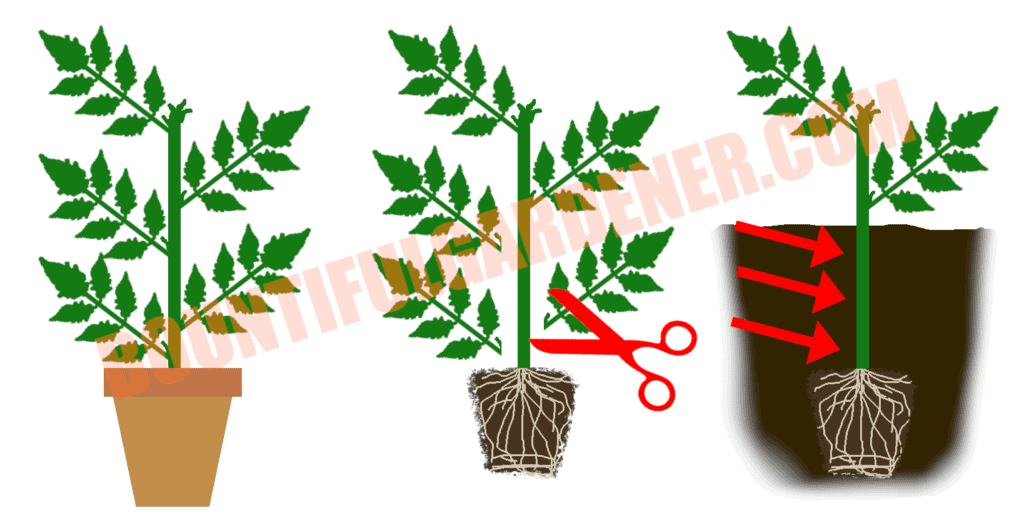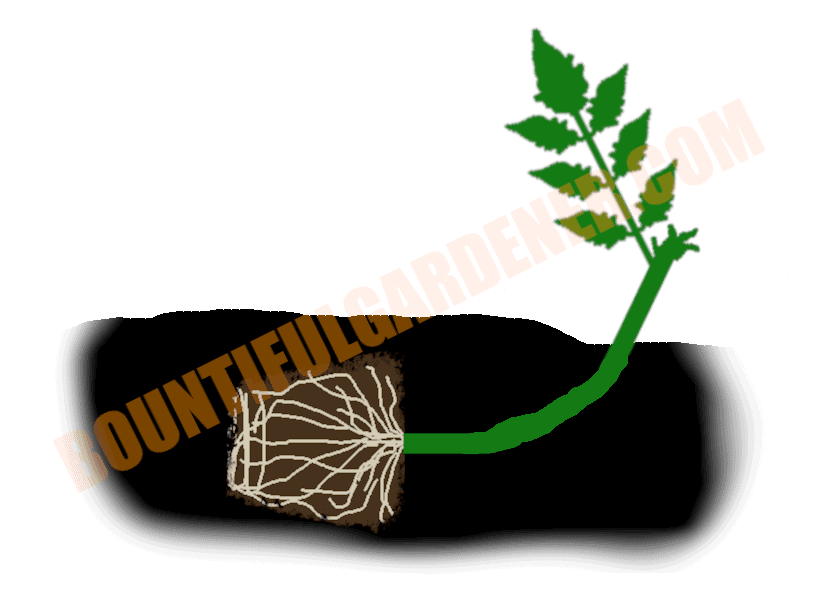You have likely heard the old phrase “plant tomatoes deep”. Is it just a fad or old wives’ tale, or is it based on science? Is it possible to plant them too deep?
Planting tomatoes deep is not just a garden hack or old wives’ tale, but a standard procedure in many nurseries and farms to ensure their tomato plants can develop a stronger root system. However, it is possible to plant tomatoes too deep. If you bury the whole tomato plant, it will die from lack of light. If you only leave the top meristem (growing tip), you are unnecessarily hindering its growth while also exposing the meristem to risk of being eaten or damaged.
On this page:
Why Tomatoes Can (And Should) Be Planted Deep
The reason tomatoes can be planted deep while other vegetables and fruits can’t (for example, strawberries should never have their crown buried) is because tomato plants can very easily produce roots all along their stem if kept moist.
Planting tomatoes deeply takes advantage of this trait by very rapidly increasing the root system of your tomato to give it a stronger anchor point and also to more effectively soak up nutrients. Tomato roots can technically grow up to 2 feet (60 cm) deep, but the majority of the root mass is in the top 12 inches (30 cm) of soil. By giving your tomato a few extra inches of depth, you can easily multiply the size of your tomato’s root system, leading to a stronger, healthier plant.
Another benefit is that it makes your tomatoes more resilient to drought. Since the root system is centered deeper than usual, your tomato plants will be able to access water in the deeper subsoil, which means your tomato plants will go through less stress during dry periods and have a higher survival rate than tomatoes not planted deep.
One last thing, another nice little thing about this is that it’s a great way to plant leggy tomato seedlings. If your tomatoes look leggy, plant them deep and turn a potential flaw into a strength.
How to Plant Tomatoes Deep (2 Methods)
There are two common methods of planting tomatoes deep: the deep hole method and the trench method. In both cases, you want to use scissors to prune off the lower leaves, keeping at least the top 4 to 6 inches or so of leaves above the soil, then burying the rest of the stem when transplanting. If you plant so deep that you just have the meristem (growing tip) exposed, your tomato seedling is more vulnerable to herbivores like slugs, rabbits, and other pests.
It’s also recommended in both cases to mix a little slow-release fertilizer (or rabbit pellets) into the planting hole so your tomato can get a little boost that will last the good part of the season.
Lastly, you should not let your soil dry out because it can take a week for new roots to start forming in the presence of moisture.
Deep Hole Method
When people think about planting tomatoes deep, they are usually thinking about digging a deep hole and plonking the tomato transplant in. That’s essentially the deep hole method. As previously mentioned, I also recommend mixing some slow-release fertilizer into the planting hole when you transplant. You can see in the figure below that where the stem is buried, that’s where new roots will start forming.

The advantage of the deep hole method is that it requires zero preparation. The downside is that you have to dig pretty deep if you have a large tomato to transplant, and if you’re growing lots of tomatoes, that work adds up.
Trench Method
The trench method is for people who find the deep hole method too tiring, but might require some planning ahead of time. Basically, instead of having the stem buried vertically under the soil, you dig a trench and lay the tomato on its side, then cover up the stem and roots with soil while bending the tip upward above the soil. The diagram below illustrates a tomato transplanted via the trench method.

You do run risk of breaking the stem, so what some people will do is lay their tomato plants on their sides at least a few days before transplanting. Since plants grow toward light, your tomato seedlings will start naturally bending upward, making it easier to transplant using the trench method. I personally prefer the deep hole method, since it’s not difficult for me to dig deeper holes, and because I believe the deeper root ball in the deep hole method makes your tomato more resilient to dry spells.
What If My Tomatoes Already Have Flowers?
It happens. You start a bit too early or the weather is cooler than expected, and some of your tomato seedlings are already producing flowers. There are two philosophies on whether to remove those flowers or just bury the stem up to a few inches below the flowers. I don’t feel strongly about either, but I tend to leave the flowers on unless the tomato is very leggy and that first truss of fruit is too close to the base of the tomato. If you have a super leggy seedling and your first tomato flowers are like halfway up the stem or lower, it might be worth sacrificing those first few tomatoes in order to have a stronger foundation for bigger yields for the rest of the season.
How Deep Should You Plant Tomatoes in Containers?
The ideal depth for containers depends on the size of your container. Plant as deep as you normally would in the ground, leaving the top 4 to 6 inches of the plant with some leaves exposed. If you are using a smaller container, my rule of thumb for small container tomatoes is to plant leaving at least 1-3 inches of soil underneath the original root ball.
